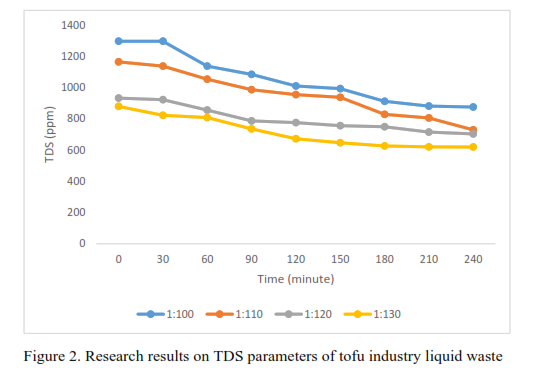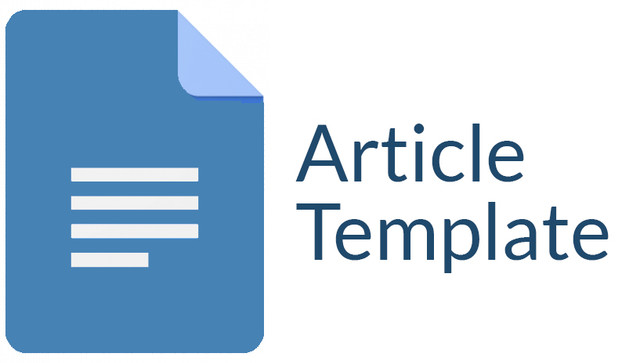Adsorption of Tofu Liquid Waste Using Rice Husk Activated Carbon
DOI:
https://doi.org/10.30736/seaj.v7i1.1170Keywords:
Rice Husk, Activated carbon, KOH, Adsorption, Tofu Liquid WasteAbstract
Adsorption of Tofu Liquid Waste Using Rice Husk Activated Carbon. Rice husk is an agricultural by-product rich in organic matter, and improper management can cause environmental pollution. Given the high carbon content in rice husk, it can be used as an adsorbent. Furthermore, the type of activator and activation technique employed impact the properties of activated carbon. Due to its ability to produce activated carbon with a high pore volume and specific surface area, KOH is a chemical substance that is frequently employed. This study sought to ascertain whether rice husks might be used as activated carbon to lower the amount of organic matter in liquid effluent from the tofu business. The results of this study indicate that rice husk activated carbon can reduce the level of TDS by 27%, TSS by 97%, and pH 6 from the initial level. The optimum contact time is 120 minutes at a ratio variation of 1:130, because at that time the activated carbon has approached saturation by the adsorbed adsorbate and experienced equilibrium and saturation.
Downloads
References
Adi, S., Masthura, M., & Daulay, A. H. (2022). Pengaruh Suhu Aktivasi Terhadap Kualitas Karbon Aktif Biji Durian. JISTech (Journal of Islamic Science and Technology), 7(1), 65–72. https://doi.org/10.30829/jistech.v7i1.12090
Alfi, R., Lubis, F., Nasution, H. I., Zubir, M., Kimia, J., Matematika, F., Alam, P., & Medan, U. N. (2020). Production of Activated Carbon from Natural Sources for Water Purification. Indonesian Journal of Chemical Science and Technology, 3(2), 67–73. https://doi.org/10.24114/ijcst.v3i2.19531
Amalia, R. N., Shalaho Dina Devy, Angga Syfa Kurniawan, Nur Hasanah, Elisa Destephani Salsabila, Dira Anis Ageung Ratnawati, Febry Muhammad Fadil, Nur Aqsan Syarif, & Guntur Arsi Aturdin. (2022). Potensi Limbah Cair Tahu sebagai Pupuk Organik Cair di RT. 31 Kelurahan Lempake Kota Samarinda. ABDIKU: Jurnal Pengabdian Masyarakat Universitas Mulawarman, 1(1), 36–41. https://doi.org/10.32522/abdiku.v1i1.38
Anggara, O. C., Asyrofi, A. A. A., Roni, D. R. S., & Putro, A. B. P. (2023). Pengujian Kualitas Air Limbah Industri Tahu di Desa Kuncen Kecamantan Padangan. Aptekmas: Jurnal Pengabdian Kepada Masyarakat, 6(3), 150–156. http://dx.doi.org/10.36257/apts.7412pp150-156
Ardianti, A. D. (2021). Eksplorasi Metode Pembuatan Bahan Aktivator Karbon Aktif dari Kulit Salak Wedi dengan Aktivator Seng Klorida (ZnCl2). Journal of Science and Technology, 2(1), 11–17. https://repository.unugiri.ac.id/id/eprint/2412/1/Artikel Inventor April.pdf
Badan Pusat Statistik Provinsi Jawa Timur. (2022). Produksi Padi dan Beras Menurut Kabupaten / Kota di Provinsi Jawa Timur, 2021 dan 2022.
Badan Standar Nasional. (2019). SNI 06-6989-3-2019 tentang Cara Uji Padatan Tersuspensi Total (Total Suspended Solid) Secara Gravimetri.
Badan Standar Nasional. (2004). SNI 06-6989-27-2019 tentang Cara Uji Padatan Terlarut Total (Total Dissolved Solid) Secara Gravimetri.
Chairunnisa, Z.N. (2023). Efektivitas Adsorben Karbon Aktif dari Tempurung Kelapa Untuk Pengolahan Limbah Cair Pabrik Tahu. Sarjana thesis, Universitas Muhammadiyah Surakarta. http://eprints.ums.ac.id/id/eprint/104733
Dewi, C.R., Khaeronnisa I., Ismuyanto, B., Juliananda, & Himma, N.F. (2017). Adsorpsi Ion Kalsium Menggunakan Biomassa Eceng Gondok (Eichhornia crassipes) Diregenerasi HCl. Jurnal Rekayasa Bahan Alam dan Energi Berkelanjutan. Vol. 1: 16-24. DOI:10.21776/UB.RBAET.2017.001.01.03
Dewi, N.M., Maelan, N.M., Andini, S., Perdani, M.S., & Wahyuningtyas, A. (2024). Pembuatan Hidrogel Berbasis Carboxylmethyl Cellulose (CMC) dan Pektin Sebagai Adsorben Logam Cu dengan Metode Frezze-Thaw. Jurnal Pengendalian pencemaran Lingkungan (JPPL), Vol. 6, No. 2: 112-119. DOI:10.35970/jppl.v6i2.2412
Novita, E., Pradana, H. A., & Aenia, S.N. (2021). Perlakuan Waktu dan Kecepatan Pengadukan Terhadap Efektivitas Adsorpsi Air Limbah Kopi. Jurnal Keteknikan Pertanian, 9(2), 41–48. https://doi.org/10.19028/jtep.09.2
Erawati, E., & Fernando, A. (2018). Pengaruh Jenis Aktivator Dan Ukuran Karbon Aktif Terhadap Pembuatan Adsorbent Dari Serbik Gergaji Kayu Sengon (Paraserianthes Falcataria). Jurnal Integrasi Proses, 7(2), 58. https://doi.org/10.36055/jip.v7i2.3808
Fisma, I.Y., & Bhernama, B.G. (2020). Analisis Air Limbah yang Masuk Pada Waste Water Plant (WWTP). Amina Ar-Raniry Chemistry Journal, Vol. 2, Issue 2: 50-58. https://garuda.kemdikbud.go.id/documents/detail/2516795
Goncalves, S.P.C., Strauss, M., Delite, F.S., Clemente, Z., Castro, V.L., Martinez, D.S.T. (2016). Activated carbon from pyrolyzed sugarcane bagasse: Silver nanoparticle modification and ecotoxicity assessment. Science of the Total Environment. 565. 833-840. DOI: 10.1016/j.scitotenv.2016.03.041
Hamidu, I., Afotey, B., Kwakye-Auwah, B., & Anang, D.A. (2025). Synthesis of silica and silicon from rice husk feedstock: A review. Heliyon, Vol. 11, Issue 4: 1-26 https://doi.org/10.1016/j.heliyon.2025.e42491
Hariyadi., Kamil, M., & Ananda, P. (2020). Sistem pengecekan pH Air Otomatis Menggunakan Sensor pH Probe Berbasis Ardunio Pada Sumur Bor. Rang Teknik Journal, Vol.3 No.2 340-346. http://dx.doi.org/10.31869/rtj.v3i2.1930
Huang, Y., Ma, E., & Zhao, G. (2015). Therma and structure analysis on reaction mechanism during the preparation of activated carbon fibers by KOH activation from liquefied wood-based fibers. Industrial crops and Products. 447-455. https://doi.org/10.1016/j.indcrop.2015.03.002
Indah, D. R. (2020). Adsorpsi Logam Tembaga (Cu) Pada Karbon Baggase Teraktivasi Natrium Hidroksida (NaOH). Jurnal Ilmiah IKIP Mataram, 7(1), 12–26. https://e-journal.undikma.ac.id/index.php/jiim/article/view/3205
Kementerian Lingkungan Hidup. (2014). Peraturan Menteri Lingkungan Hidup Republik Indonesia Nomor 5 Tahun 2014 tentang Baku Mutu Air Limbah Domestik.
Kusniawati, E., Sari, D., & Mareska, P. (2023). Pemanfaatan Sekam Padi sebagai Karbon Aktif untuk Menurunkan Kadar pH, Turbidity, TSS, dan TDS. 2(10), 4183–4198. DOI:10.53625/jirk.v2i10.5405
Luna, P., Hoerudin, Usmiati, S., & Sunarmani. (2020). Teknologi Pembuatan Adsorben Dari Limbah Ekstraksi Biosilika Sekam Padi. Pasundan Food Technology Journal, 7(3), 116–125. https://doi.org/10.23969/pftj.v7i3.3001
Lestari, D. I., Yuliansyah, A. T., & Budiman, A. (2022). Adsorption studies of KOH-modified hydrochar derived from sugarcane bagasse for dye removal: Kinetic, isotherm, and thermodynamic study. Communications in Science and Technology, 7(1), 15-22. https://doi.org/10.21924/cst.7.1.2022.669
Nurlina, Zahara, T.A., Gusrizal, Kartika, I.D. (2015). Efektivitas Penggunaan Tawas dan Karbon Aktif Pada Pengolahan Limbah Cair Industri Tahu. Prosiding SEMIRATA 2015 Bidang MIPA BKS-PTN Barat Universitas Tanjungpura, Pontianak. Hal. 690-699. jurnal.untan.ac.id · index · semirata2015
Oktariani, E.N. (2021). Pembuatan karbon aktif dari sekam padi teraktivasi NaOH dan KOH dengan modifikasi MgO sebagai adsorben gas buang CO dan hidrokarbon = Utilization of rice husk as activated carbon modified with MgO for CO2 and hydrocarbons gas adsorption in motor vehicle emissions. Sarjana thesis, Universitas Indonesia. https://lib.ui.ac.id/detail?id=20519404&lokasi=lokal
Patulak, A.M. & Damayanti. (2022). Efektivitas Karbon Aktif Kulit Buah Kelapa Muda Pada Pengolahan Limbah Cair Pabrik Tahu. Laporan Tugas Akhir, Politeknik Negeri Ujung Pandang. https://repository.poliupg.ac.id/id/eprint/2445/1
Purnawan, C., Martini, T., & Afidah, S. (2014). Penurunan Kadar Protein Limbah Cair Tahu dengan Pemanfaatan Karbon Bagasse Teraktivasi. J. Manusia dan Lingkungan, Vol. 21 No.2, 143-148. DOI:10.22146/jml.18537
Rahman, T., Muis, L., Suryadri, H. (2022). Pengaruh Berat Unggun terhadap Efisiensi dan kapasitas Adsorpsi Zat Warna Rhodamin dengan Sistem Kontinyu. Jurnal Engineering, Vol. 4 No. 1, 32-38
Riyanto, C.A., Kurniawan, E. & Aminu, N.A. (2021). Pengaruh NaOH dan Suhu Aktivasi Terhadap Karakteristik KarbonAktif Sekam Padi Teraktivasi H3PO4. Rafflesia Journal of Natural and Applied Sciences, 1(2), 59–68. DOI:10.33369/rjna.v1i2.16864
Safitri, D. I., Hendrawati, N., & Ramadhana, R. (2024). Pemanfaatan Tongkol Jagung dalam Pembuatan Karbon Aktif dengan Aktivator NaOH dan Na2CO3. Distilat: Jurnal Teknologi Separasi, 10(1), 113–121. https://doi.org/10.33795/distilat.v10i1.4939
Saputro, E. A., Wulan, V. D. R., Winata, B. Y., Yogaswara, R. R., & Erliyanti, N. K. (2020). Process of Activated Carbon from Coconut Shells Through Chemical Activation. Natural Science: Journal of Science and Technology, 9(1).https://doi.org/10.22487/25411969.2020.v9.i1.15042
Sayow, F., Polii, B. V. J., Tilaar, W., & Augustine, K. D. (2020). Analisis Kandungan Limbah Industri Tahu dan Tempe Rahayu di Kelurahan Uner Kecamatan Kawangkoan Kabupaten Minahasa. Agri-Sosioekonomi, 16(2), 245-252. https://doi.org/10.35791/agrsosek.16.2.2020.28758
Schlenker, S. (2021). Standard operating procedure. Textile Chemist and Colorist, 29(7), 283–286. https://doi.org/10.5055/jem.2005.0060
Setyaningrum, N.E., Santoso, B.B., & Mangallo, B. (2019). Studi adsorpsi limbah organik industri tahu tempe dengan karbon aktif kayu merbau [Intsia bijuga (Colebr) O.Kuntze]. Cassowary, Vol. 2(1): 86-101 https://doi.org/10.30862/casssowary.cs.v2.i1.24
Sjafruddin, R., Ardi, M., & Arsyad, M. (2024). Potensi Pengolahan Air Limbah Industri Tahu sebagai Langkah Mendukung Industri Berkelanjutan. Sainsmat : Jurnal Ilmiah Ilmu Pengetahuan Alam, 13(1), 35. https://doi.org/10.35580/sainsmat131589762024
Sutama, D.K., & Megantara, D. (2018). Penyisihan Ion Sulfat Menggunakan Karbon Aktif dari Jerami Padi dengan Aktivasi ZnCl2. Sarjana thesis, Universitas Brawijaya. https://repository.ub.ac.id/id/eprint/11656/
Toruan, P. lumban, , R., & Setiawan, A. A. (2022). Konduktivitas Listrik Ion Terlarut: Studi Kasus di Air Sumur TPA Sukawinatan Palembang. Jurnal Redoks, 7(1), 48–54. https://doi.org/10.31851/redoks.v7i1.6760
Wardalia, W., Rusdi, R., Hartono, R., & Adiwibowo, M. T. (2021). Pengaruh Jenis Aktivasi Pada Adsorben Cangkang Kacang Tanah Terhadap Adsorpsi Metil Violet. Jurnal Integrasi Proses, 10(2), 115. https://doi.org/10.36055/jip.v10i2.13050
Wibowo, R. & Mualiq, I., (2017). Optimasi Proses Pirolisis Pada Pembuatan Briket Berbahan Ampas Batang Tebu dan Sekam Padi. Jurnal Seminar Nasional Publikasi Hasil-Hasil Penelitian Dan Pengabdian Masyarakat, September, 315–318. https://jurnal.unimus.ac.id/index.php/psn12012010/article/view/2880
Wibowo, S., Syafi, W., & Pari, Gustan. (2021) Karakterisasi Permukaan Arang Aktif Tempurung Biji Nyamplung. Jurnal Teknologi. Bol. 15: 17-24. DOI:10.7454/mst.v15i1.852

Downloads
Published
How to Cite
Issue
Section
License
Copyright (c) 2025 Daning Kinanti Sutama, Aulia Firda Alfiana, Nadya Rizkita, Dwi Indah Lestari, Siti Aminah

This work is licensed under a Creative Commons Attribution-ShareAlike 4.0 International License.
Authors who publish with this journal agree to the following terms:
- Authors retain copyright and grant the journal right of first publication with the work simultaneously licensed under a Creative Commons Attribution-ShareAlike 4.0 International License that allows others to share the work with an acknowledgment of the work's authorship and initial publication in this journal.
- Authors are able to enter into separate, additional contractual arrangements for the non-exclusive distribution of the journal's published version of the work (e.g., post it to an institutional repository or publish it in a book), with an acknowledgment of its initial publication in this journal.
- Authors are permitted and encouraged to post their work online (e.g., in institutional repositories or on their website) prior to and during the submission process, as it can lead to productive exchanges, as well as earlier and greater citation of published work (See The Effect of Open Access).

This work is licensed under a Creative Commons Attribution-ShareAlike 4.0 International License.









